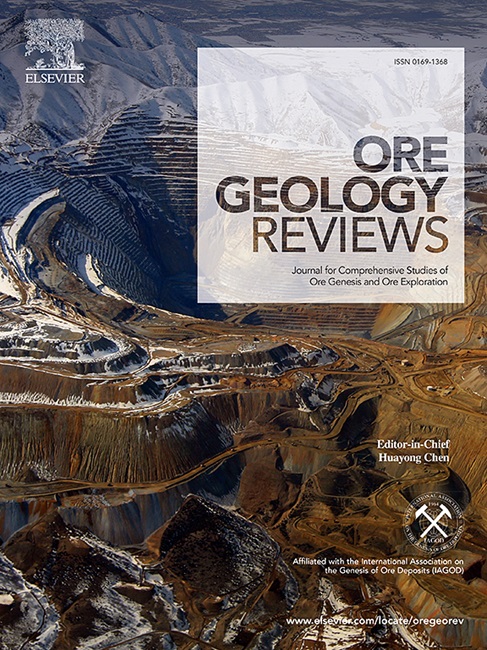Coloration mechanism of Fe in sphalerite based on LA-ICP-MS and DFT: A case study of the Huize super-large Ge-rich Ag–Pb–Zn deposit in Sichuan–Yunnan–Guizhou
IF 3.2
2区 地球科学
Q1 GEOLOGY
引用次数: 0
Abstract
The Fe content is a crucial factor influencing the color of sphalerite. This study focuses on sphalerite from the Huize super-large Ge-rich Ag–Pb–Zn deposit in the Sichuan–Yunnan–Guizhou border region. Based on LA-ICP-MS in-situ analysis and quantum chemical calculations using Density Functional Theory (DFT), we investigated the Fe–Zn substitution patterns and their impact on sphalerite color, identified the isomorphous and interstitial doping modes of iron in sphalerite, and further elucidated the coloration mechanism and mineralization process of sphalerite. The research shows that black sphalerite from the Baizuo Formation in this deposit has the highest Fe content, while red-brown sphalerite from the Dengying Formation has the highest Fe content among its counterparts. When the number of Fe atoms in the ZnS electronic structure exceeds six, the reflection coefficient in the red-brown spectral range is significantly higher than that in other visible light bands, while the absorption coefficient is lower. The isomorphous substitution and interstitial insertion of Fe in sphalerite are key factors leading to its color variation. Fe predominantly enters the (110) and (100) cleavage planes in the form of isomorphous substitution, forming isomorphous mixed crystals, with the (110) cleavage plane being more sensitive to Fe substitution. The study suggests that the mineralization temperature corresponding to different mineralization stages affects the Fe content in sphalerite, which in turn determines its color presentation. This further supports the evolution process of the ore-forming fluid from medium–to–high temperature, and low salinity to medium temperature, and medium salinity, and finally to low temperature, and medium–to–low salinity. This paper provides a new theoretical perspective for revealing the coloration mechanism of sphalerite.

基于LA-ICP-MS和DFT的闪锌矿铁显色机理研究——以川云贵会泽超大型富锗银铅锌矿为例
铁含量是影响闪锌矿颜色的重要因素。以川云贵交界地区会泽超大型富锗银铅锌矿床闪锌矿为研究对象。基于LA-ICP-MS原位分析和密度泛函理论(DFT)量子化学计算,研究了Fe-Zn取代模式及其对闪锌矿颜色的影响,鉴定了铁在闪锌矿中的同构和间隙掺杂模式,并进一步阐明了闪锌矿的显色机理和成矿过程。研究表明,该矿床白左组黑色闪锌矿铁含量最高,灯影组红棕色闪锌矿铁含量最高。当ZnS电子结构中的Fe原子数超过6个时,其在红棕色光谱范围内的反射系数明显高于其他可见光波段,而吸收系数则较低。铁在闪锌矿中的同构取代和间隙插入是导致闪锌矿颜色变化的关键因素。铁主要以同构取代的形式进入(110)和(100)解理面,形成同构混合晶体,其中(110)解理面对铁取代更为敏感。研究表明,不同成矿阶段对应的成矿温度影响闪锌矿中的铁含量,进而决定闪锌矿的颜色表现。这进一步支持了成矿流体从中高温、低矿化度到中温、中矿化度,再到低温、中低矿化度的演化过程。为揭示闪锌矿的显色机理提供了新的理论视角。
本文章由计算机程序翻译,如有差异,请以英文原文为准。
求助全文
约1分钟内获得全文
求助全文
来源期刊

Ore Geology Reviews
地学-地质学
CiteScore
6.50
自引率
27.30%
发文量
546
审稿时长
22.9 weeks
期刊介绍:
Ore Geology Reviews aims to familiarize all earth scientists with recent advances in a number of interconnected disciplines related to the study of, and search for, ore deposits. The reviews range from brief to longer contributions, but the journal preferentially publishes manuscripts that fill the niche between the commonly shorter journal articles and the comprehensive book coverages, and thus has a special appeal to many authors and readers.
 求助内容:
求助内容: 应助结果提醒方式:
应助结果提醒方式:


